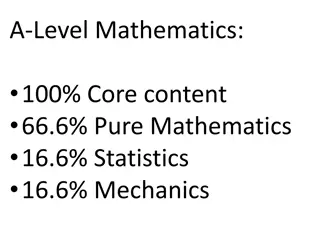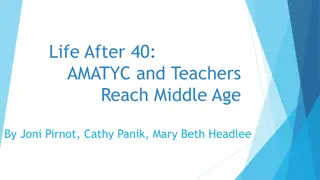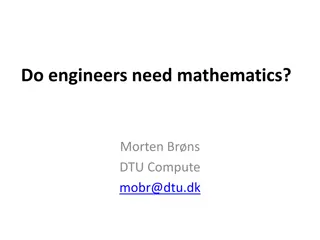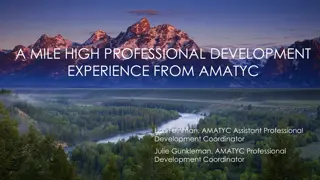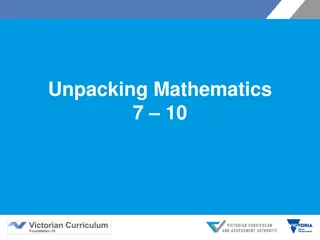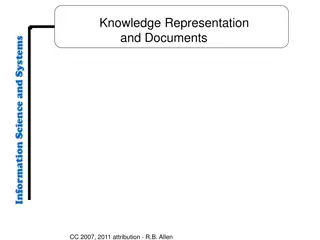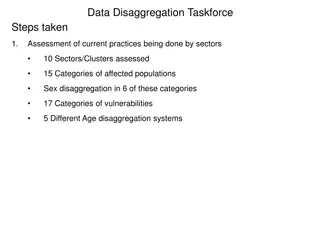Mathematics Explained: Organization, Categories, and More
Dive into the realm of mathematics, exploring concepts like number properties, equations, functions, geometry, data analysis, and probability. Understand the challenges of structuring content and picking categories while grasping the importance of clarity in mathematical language. Discover the perspectives of mathematicians, educational systems like PISA and NAEP, and the emphasis on simplicity and precision in mathematics education.
Download Presentation

Please find below an Image/Link to download the presentation.
The content on the website is provided AS IS for your information and personal use only. It may not be sold, licensed, or shared on other websites without obtaining consent from the author.If you encounter any issues during the download, it is possible that the publisher has removed the file from their server.
You are allowed to download the files provided on this website for personal or commercial use, subject to the condition that they are used lawfully. All files are the property of their respective owners.
The content on the website is provided AS IS for your information and personal use only. It may not be sold, licensed, or shared on other websites without obtaining consent from the author.
E N D
Presentation Transcript
Section 3: The New Deal: 1935 and Beyond Essential Question How did Georgia s economy begin to rebound with more New Deal programs after 1936? 1
Section 3: The New Deal: 1935 and Beyond What terms do I need to know? cooperative recession minimum wage 2
The New Deal: 1935 and Beyond In spite of New Deal programs enacted during Roosevelt s first administration, millions of Americans remained out of work. The election of 1936 brought new groups of voters into the Democratic Party. The election of Governor Ed Rivers meant that Georgia could now participate in New Deal programs that former Governor Eugene Talmadge had blocked. Georgia s economy began to emerge from long years of depression. 3
Rural Electrification The Rural Electrification Act (REA) provided government loans to groups of farmers in a rural area. The farmers could form an electrical cooperative, a company owned and operated for the benefit of those using its services. REA allowed Georgia s rural farms to receive electricity. This allowed them to use the same labor-saving devices that city dwellers enjoyed. As a result of the REA, this woman was able to have an electric stove. Such a device was much safer and easier to use than a wood or coal- burning stove. Image: U.S. Government 4
Social Security Americans would receive a retirement pension based on money they paid into Social Security while working. Employers matched the amount of money the employees paid. The act provided that federal money would go to the states to provide aid for dependent children and their mothers. Unemployment insurance, paid for by state and federal governments, was also provided. Many Georgians were not covered by Social Security since farm laborers and domestic workers were not covered. Georgia s workers were not eligible until Talmadge left the governor s office in 1936, because he refused to set up state agencies to administer the program. 5
The Election of 1936 President Roosevelt easily won reelection, including winning the votes of African Americans in the north, who had voting rights. In Georgia, Richard Russell defeated Eugene Talmadge for the U.S. Senate seat. Russell supported Roosevelt and his New Deal policies. Senator Walter F. George of Georgia was reelected. Ed Rivers, a New Deal supporter, won the governorship, and thousands of Georgians benefitted from participating in the programs. Governor Rivers also passed education reform, including a longer school year. The state paid for textbooks for schoolchildren. Link: Richard B. Russell 6
The New Deals Final Years In 1938, the country went into a recession, or economic slowdown. Many Southerners opposed the Fair Labor Standards Act, which established a minimum wage and 40-hour work week. They believed that business would have to reduce the number of workers in order to pay the minimum wage. The minimum wage was the least an employer could pay an employee per hour. Not all of Roosevelt s New Deal reforms were approved by Congress. 8
The Effects of the New Deal The New Deal resulted in many improvements in Georgia, including flood control levees, paved roads, schools, murals and theatrical productions, and development of historic sites. The national government enacted programs that directly benefited its citizens instead of leaving that up to state or local governments. Georgia leaders supported New Deal programs that helped farmers. Leaders were skeptical of programs that regulated industries and targeted factory workers. The New Deal helped modernize Georgia. Transportation improved and agriculture changed permanently with better equipment and new varieties of crops. The economy improved, but did not recover until the United States entered World War II in the 1940s. 9







